cruise control MERCEDES-BENZ GLS-Class SUV 2017 X166 Owner's Manual
[x] Cancel search | Manufacturer: MERCEDES-BENZ, Model Year: 2017, Model line: GLS-Class SUV, Model: MERCEDES-BENZ GLS-Class SUV 2017 X166Pages: 390, PDF Size: 9.71 MB
Page 10 of 390
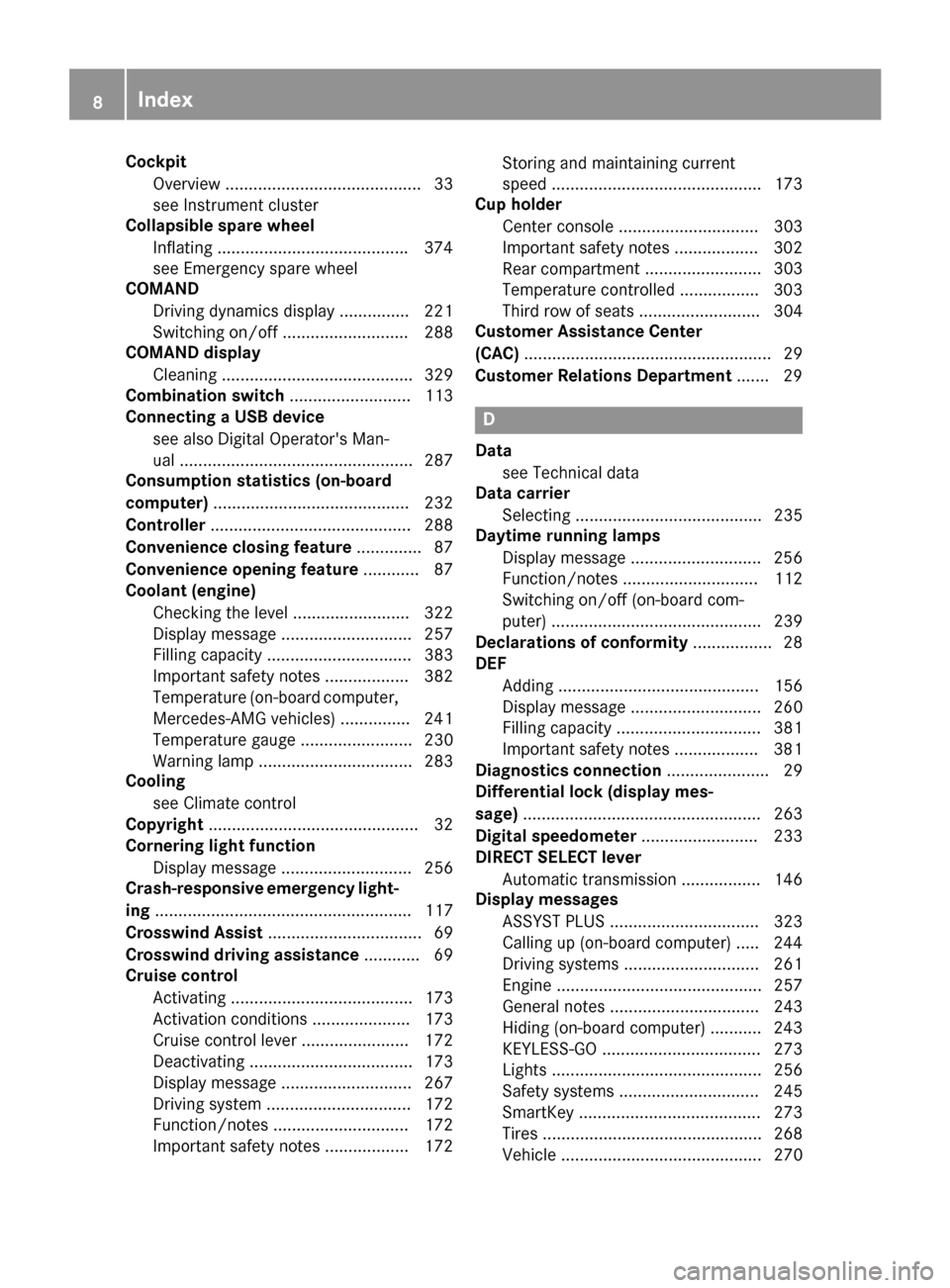
CockpitOverview .......................................... 33
see Instrument cluster
Collapsible spare wheel
Inflating ........................................ .374
see Emergency spare wheel
COMAND
Driving dynamics display ............... 221
Switching on/off ........................... 288
COMAND display
Cleaning ......................................... 329
Combination switch .......................... 113
Connecting a USB device
see also Digital Operator's Man-
ual .................................................. 287
Consumption statistics (on-board
computer) .......................................... 232
Controller ........................................... 288
Convenience closing feature .............. 87
Convenience opening feature ............ 87
Coolant (engine)
Checking the level ......................... 322
Display message ............................ 257
Filling capacity ............................... 383
Important safety notes .................. 382
Temperature (on-board computer,
Mercedes-AMG vehicles) ............... 241
Temperature gauge ........................ 230
Warning lamp ................................. 283
Cooling
see Climate control
Copyright ............................................. 32
Cornering light function
Display message ............................ 256
Crash-responsive emergency light-
ing ....................................................... 117
Crosswind Assist ................................. 69
Crosswind driving assistance ............ 69
Cruise control
Activating ....................................... 173
Activation conditions ..................... 173
Cruise control lever ....................... 172
Deactivating ................................... 173
Display message ............................ 267
Driving system ............................... 172
Function/notes ............................. 172
Important safety notes .................. 172 Storing and maintaining current
speed ............................................. 173
Cup holder
Center console .............................. 303
Important safety notes .................. 302
Rear compartm ent ......................... 303
T
emperature controlled ................. 303
Third row of seats .......................... 304
Customer Assistance Center
(CAC) ..................................................... 29
Customer Relations Department ....... 29
D
Data
see Technical data
Data carrier
Selecting ........................................ 235
Daytime running lamps
Display message ............................ 256
Function/notes ............................. 112
Switching on/off (on-board com-
puter) ............................................. 239
Declarations of conformity ................. 28
DEF
Adding ........................................... 156
Display message ............................ 260
Filling capacity ............................... 381
Important safety notes .................. 381
Diagnostics connection ...................... 29
Differential lock (display mes-
sage) ................................................... 263
Digital speedometer ......................... 233
DIRECT SELECT lever
Automatic transmission ................. 146
Display messages
ASSYST PLUS ................................ 323
Calling up (on-board computer) ..... 244
Driving systems ............................. 261
Engine ............................................ 257
General notes ................................ 243
Hiding (on-board computer) ........... 243
KEYLESS-GO .................................. 273
Lights ............................................. 256
Safety systems .............................. 245
SmartKey ....................................... 273
Tires ............................................... 268
Vehicle ........................................... 270
8Index
Page 11 of 390
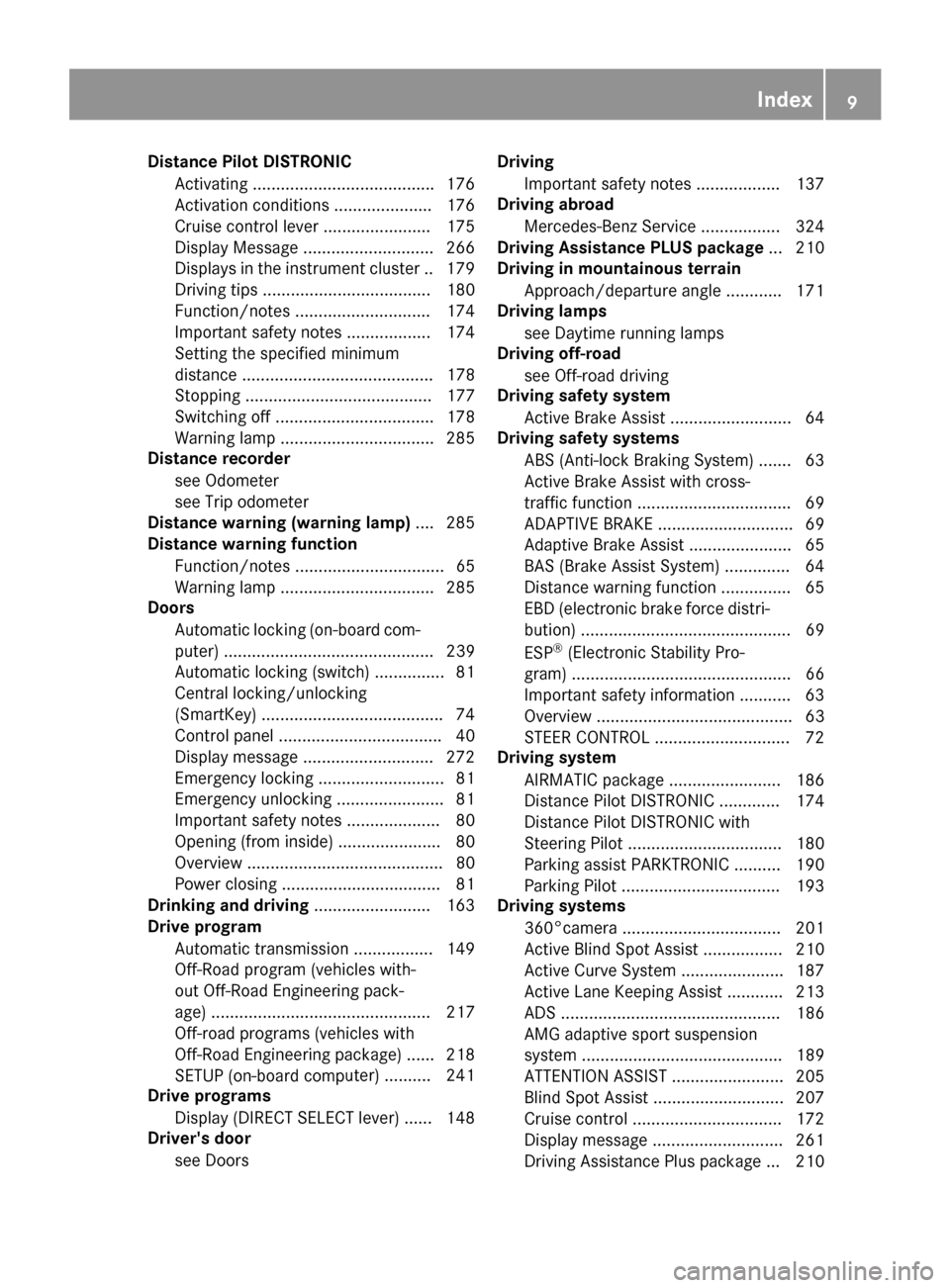
DistancePilot DISTRONIC
Activatin g...................................... .176
Activation conditions ..................... 176
Cruise control lever ....................... 175
Display Message ............................ 266
Displays in the instrument cluster .. 179
Driving tips ....................................1 80
Function/notes .............................1 74
Important safety notes .................. 174
Setting the specified minimum
distance ......................................... 178
Stopping ........................................ 177
Switching off .................................. 178
Warning lamp ................................. 285
Distance recorder
see Odometer
see Trip odometer
Distance warning (warning lamp) .... 285
Distance warning function
Function/notes ................................ 65
Warning lamp ................................. 285
Doors
Automatic locking (on-board com-
puter) ............................................. 239
Automatic locking (switch) ...............8 1
Central locking/unlocking
(SmartKey) ...................................... .74
Control panel .................................. .40
Display message ............................ 272
Emergency locking ........................... 81
Emergency unlocking ....................... 81
Important safety notes .................... 80
Opening (from inside) ...................... 80
Overview .......................................... 80
Power closing .................................. 81
Drinking and driving ......................... 163
Drive program
Automatic transmission ................. 149
Off-Road program (vehicles with-
out Off-Road Engineering pack-
age) ............................................... 217
Off-road programs (vehicles with
Off-Road Engineering package) ...... 218
SETUP (on-board comp uter) .......... 241
D
rive programs
Display (DIRECT SELECT lever) ...... 148
Driver's door
see Doors Driving
Important safety notes .................. 137
Driving abroad
Mercedes-Benz Service ................. 324
Driving Assistance PLUS package ... 210
Driving in mountainous terrain
Approach/departure angle ............ 171
Driving lamps
see Daytime running lamps
Driving off-road
see Off-road driving
Driving safety system
Active Brake Assist .......................... 64
Driving safety systems
ABS (Anti-lock Braking System) ....... 63
Active Brake Assist with cross-
traffic function ................................. 69
ADAPTIVE BRAKE ............................. 69
Adaptive Brake Assist ...................... 65
BAS (Brake Assist System) .............. 64
Distance warning function ............... 65
EBD (electronic brake force distri-
bution) ............................................. 69
ESP
®(Electronic Stability Pro-
gram) ............................................... 66
Important safety information ........... 63
Overview .......................................... 63
STEER CONTROL ............................. 72
Driving system
AIRMATIC package ........................ 186
Distance Pilot DISTRONIC ............. 174
Distance Pilot DISTRONIC with
Steering Pilot ................................. 180
Parking assist PARKTRONIC .......... 190
Parking Pilot .................................. 193
Driving systems
360°camera .................................. 201
Active Blind Spot Assist ................. 210
Active Curve System ...................... 187
Active Lane Keeping Assist ............ 213
ADS ............................................... 186
AMG adaptive sport suspension
system ........................................... 189
ATTENTION ASSIST ........................ 205
Blind Spot Assist ............................ 207
Cruise control ................................ 172
Display message ............................ 261
Driving Assistance Plus package ... 210
Index9
Page 22 of 390
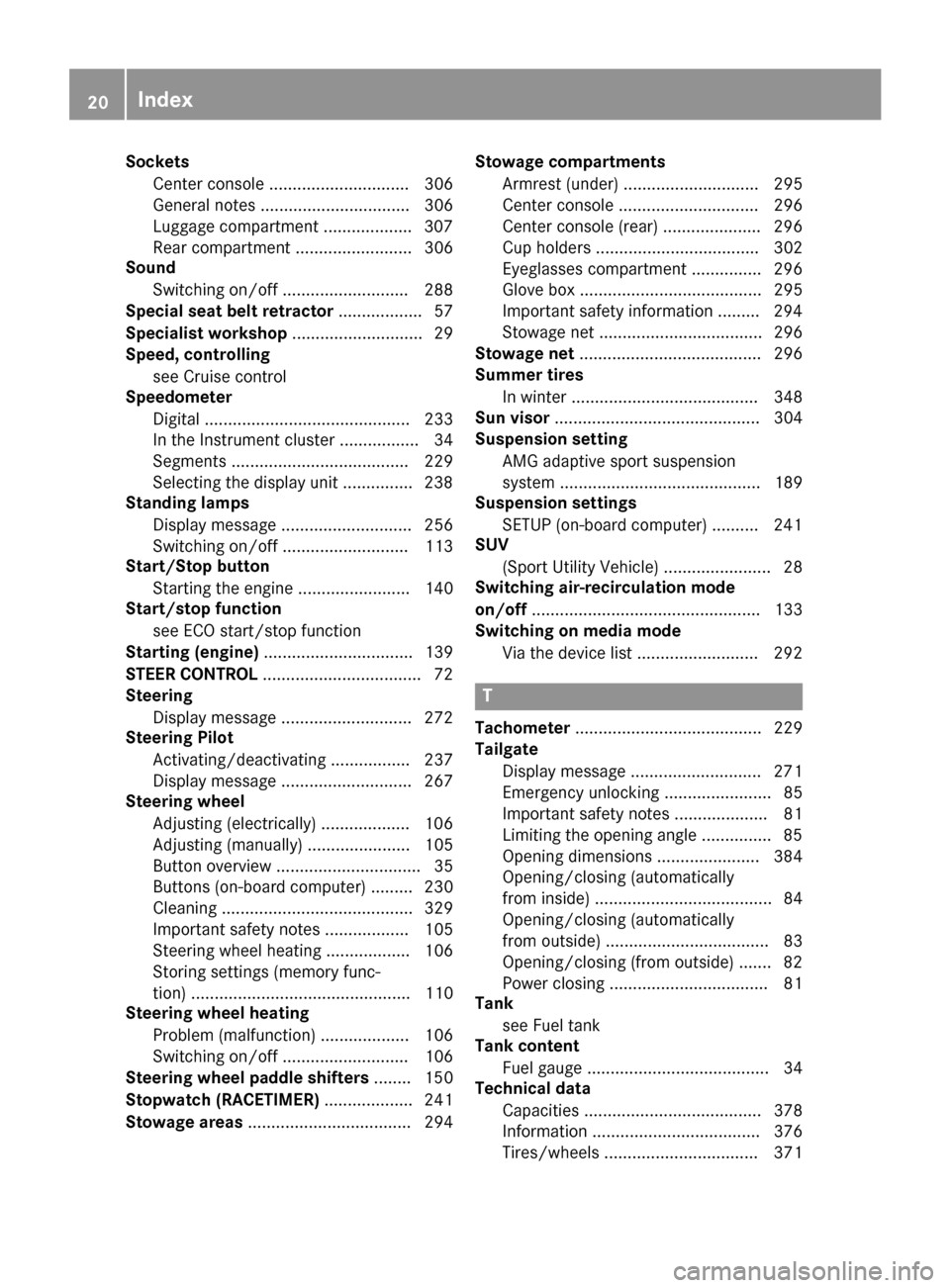
SocketsCenter console .............................. 306
General notes ................................ 306
Luggage compartment ...................3 07
Rear compartment ......................... 306
Sound
Switching on/off ........................... 288
Special seat belt retractor .................. 57
Specialist workshop ............................ 29
Speed, controlling
see Cruise control
Speedometer
Digital ............................................ 233
In the Instrument cluster ................. 34
Segments ...................................... 229
Selecting the display unit ...............2 38
Standing lamps
Display message ............................ 256
Switching on/off ........................... 113
Start/Stop button
Starting the engine ........................ 140
Start/stop function
see ECO start/stop function
Starting (engine) ................................ 139
STEER CONTROL .................................. 72
Steering
Display message ............................ 272
Steering Pilot
Activating/deactivating ................. 237
Display message ............................ 267
Steering wheel
Adjusting (electrically) ................... 106
Adjusting (manually) ...................... 105
Button overview ............................... 35
Buttons (on-board computer) ......... 230
Cleaning ......................................... 329
Important safety notes .................. 105
Steering wheel heating .................. 106
Storing settings (memory func-
tion) ............................................... 110
Steering wheel heating
Problem (malfunction) ................... 106
Switching on/off ........................... 106
Steering wheel paddle shifters ........ 150
Stopwatch (RACETIMER) ................... 241
Stowage areas ................................... 294 Stowage compartments
Armrest (under) ............................. 295
Center console .............................. 296
Center console (rear) ..................... 296
Cup holders ................................... 302
Eyeglasses compartment ............... 296
Glove box ....................................... 295
Important safety information ......... 294
Stowage net ................................... 296
Stowage ne t
....................................... 296
Summe
r tires
In winter ........................................ 348
Sun visor ............................................ 304
Suspension setting
AMG adaptive sport suspension
system ........................................... 189
Suspension settings
SETUP (on-board computer) .......... 241
SUV
(Sport Utility Vehicle) ....................... 28
Switching air-recirculation mode
on/off ................................................. 133
Switching on media mode
Via the device list .......................... 292
T
Tachometer ........................................ 229
Tailgate
Display message ............................ 271
Emergency unlocking ....................... 85
Important safety notes .................... 81
Limiting the opening angle ............... 85
Opening dimensions ...................... 384
Opening/closing (automatically
from inside) ...................................... 84
Opening/closing (automatically
from outside) ................................... 83
Opening/closing (from outside) ....... 82
Power closing .................................. 81
Tank
see Fuel tank
Tank content
Fuel gauge ....................................... 34
Technical data
Capacities ...................................... 378
Information .................................... 376
Tires/wheels ................................. 371
20Index
Page 35 of 390
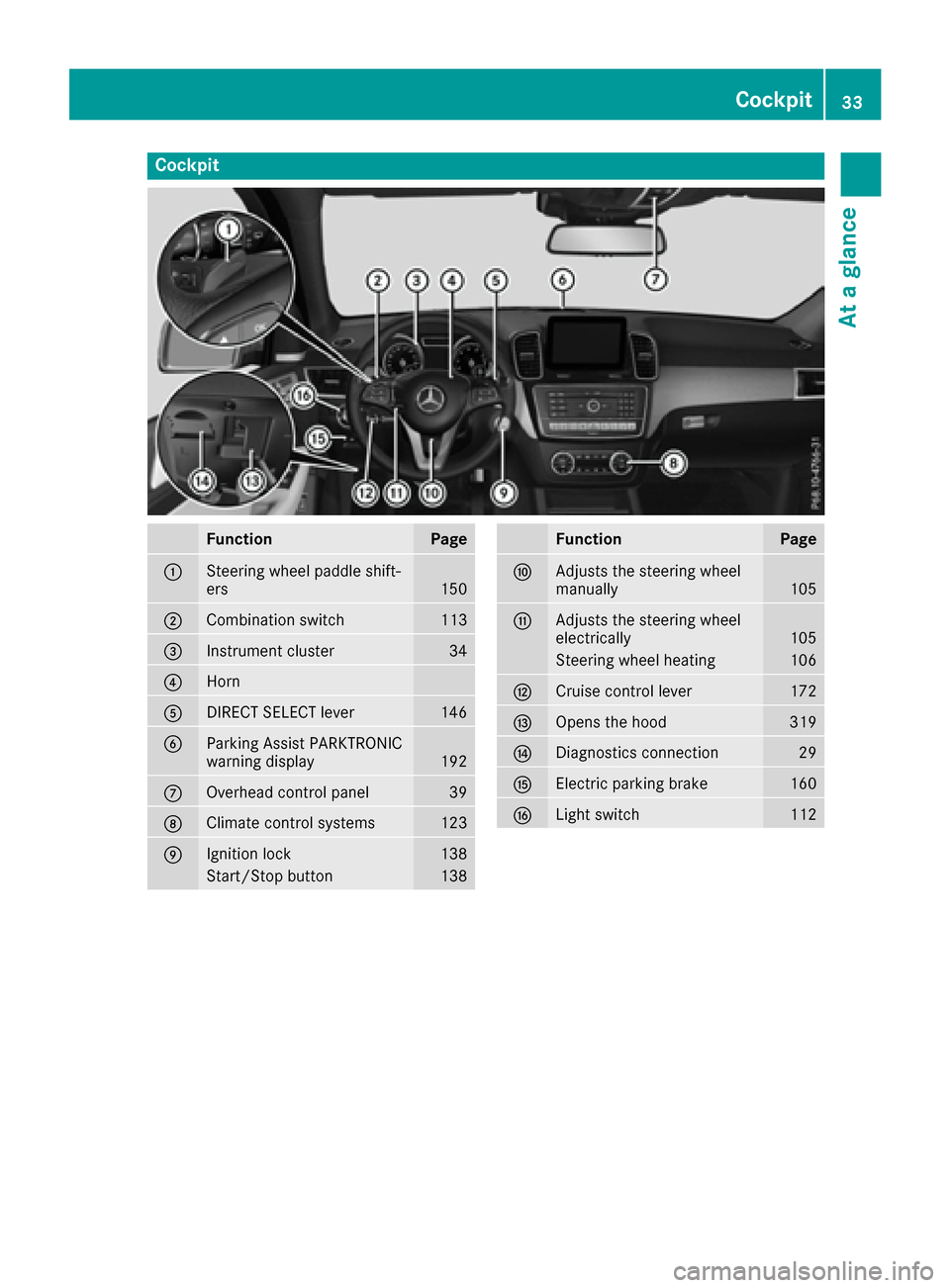
Cockpit
FunctionPage
:Steering wheel paddle shift-
ers150
;Combination switch113
=Instrument cluster34
?Horn
ADIRECT SELECT lever146
BParking Assist PARKTRONIC
warning display192
COverhead control panel39
DClimate control systems123
EIgnition lock138
Start/Stop button138
FunctionPage
FAdjusts the steering wheel
manually105
GAdjusts the steering wheel
electrically105
Steering wheel heating106
HCruise control lever172
IOpens the hood319
JDiagnostics connection29
KElectric parking brake160
LLight switch112
Cockpit33
At a glance
Page 151 of 390
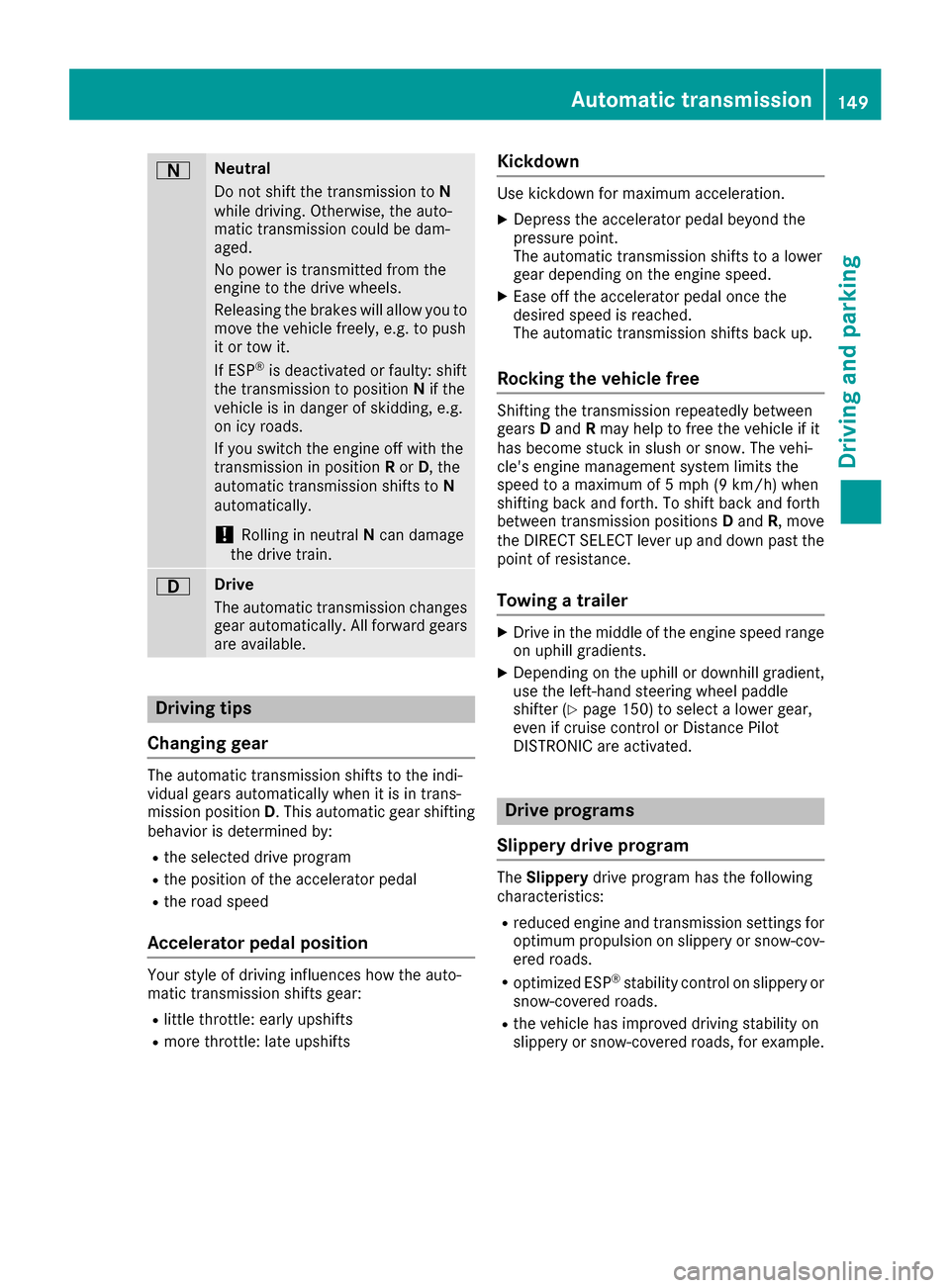
ANeutral
Do not shift the transmission toN
while driving. Otherwise, the auto-
matic transmission could be dam-
aged.
No power is transmitted from the
engine to the drive wheels.
Releasing the brakes will allow you to
move the vehicle freely, e.g. to push
it or tow it.
If ESP
®is deactivated or faulty: shift
the transmission to position Nif the
vehicle is in danger of skidding, e.g.
on icy roads.
If you switch the engine off with the
transmission in position Ror D, the
automatic transmission shifts to N
automatically.
!Rolling in neutral Ncan damage
the drive train.
7Drive
The automatic transmission changes
gear automatically. All forward gears
are available.
Driving tips
Changing gear
The automatic transmission shifts to the indi-
vidual gears automatically when it is in trans-
mission position D. This automatic gear shifting
behavior is determined by:
Rthe selected drive program
Rthe position of the accelerator pedal
Rthe road speed
Accelerator pedal position
Your style of driving influences how the auto-
matic transmission shifts gear:
Rlittle throttle: early upshifts
Rmore throttle: late upshifts
Kickdown
Use kickdown for maximum acceleration.
XDepress the accelerator pedal beyond the
pressure point.
The automatic transmission shifts to a lower
gear depending on the engine speed.
XEase off the accelerator pedal once the
desired speed is reached.
The automatic transmission shifts back up.
Rocking the vehicle free
Shifting the transmission repeatedly between
gears Dand Rmay help to free the vehicle if it
has become stuck in slush or snow. The vehi-
cle's engine management system limits the
speed to a maximum of 5 mph (9 km/h) when
shifting back and forth. To shift back and forth
between transmission positions Dand R, move
the DIRECT SELECT lever up and down past the
point of resistance.
Towing a trailer
XDrive in the middle of the engine speed range
on uphill gradients.
XDepending on the uphill or downhill gradient,
use the left-hand steering wheel paddle
shifter (
Ypage 150) to select a lower gear,
even if cruise control or Distance Pilot
DISTRONIC are activated.
Drive programs
Slippery drive program
The Slippery drive program has the following
characteristics:
Rreduced engine and transmission settings for
optimum propulsion on slippery or snow-cov-
ered roads.
Roptimized ESP®stability control on slippery or
snow-covered roads.
Rthe vehicle has improved driving stability on
slippery or snow-covered roads, for example.
Automatic transmission149
Driving an d parking
Z
Page 167 of 390
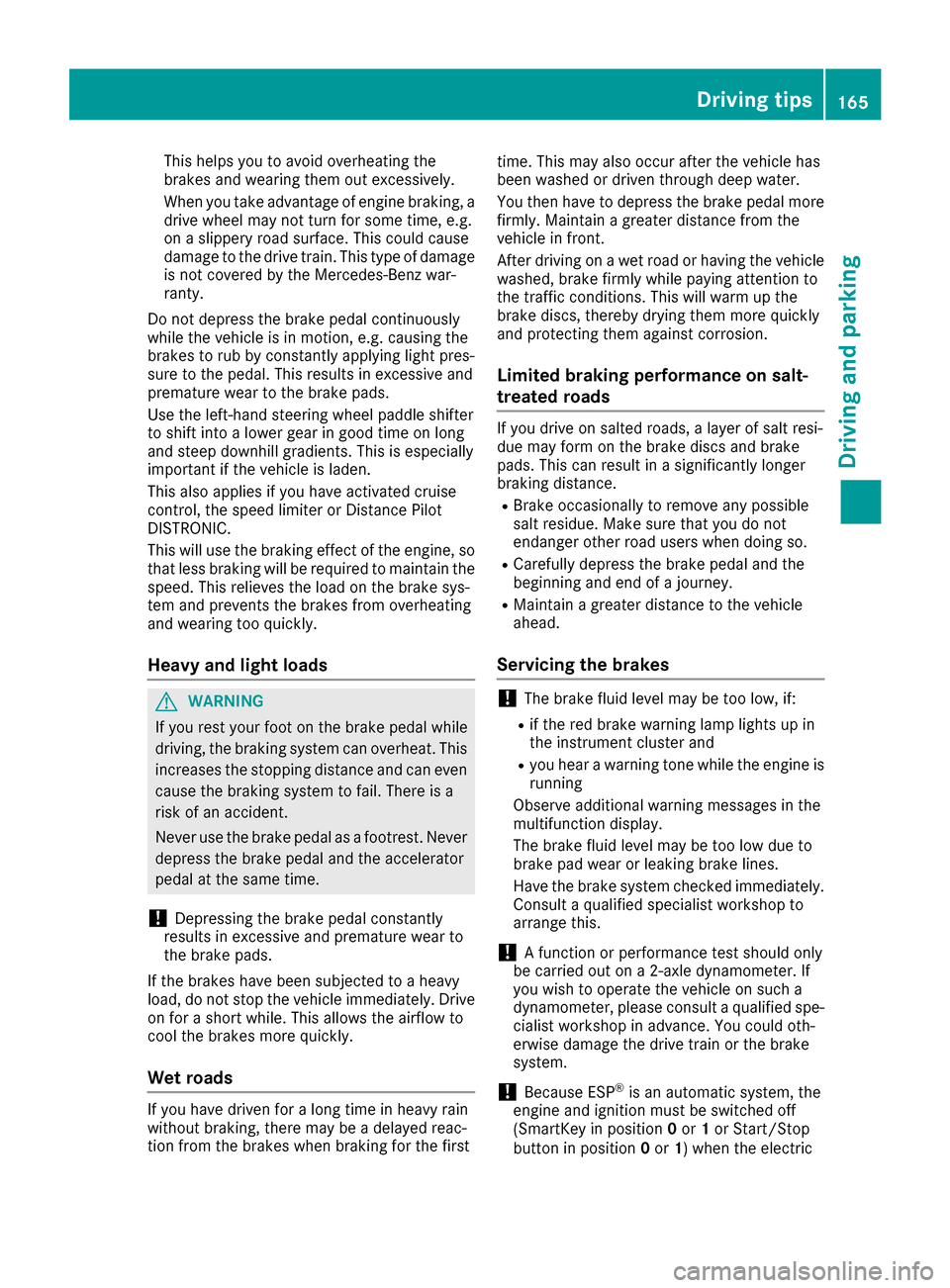
This helps you to avoid overheating the
brakes and wearing them out excessively.
When you take advantage of engine braking, a
drive wheel may not turn for some time, e.g.
on a slippery road surface. This could cause
damage to the drive train. This type of damage is not covered by the Mercedes-Benz war-
ranty.
Do not depress the brake pedal continuously
while the vehicle is in motion, e.g. causing the
brakes to rub by constantly applying light pres-
sure to the pedal. This results in excessive and
premature wear to the brake pads.
Use the left-hand steering wheel paddle shifter
to shift into a lower gear in good time on long
and steep downhill gradients. This is especially
important if the vehicle is laden.
This also applies if you have activated cruise
control, the speed limiter or Distance Pilot
DISTRONIC.
This will use the braking effect of the engine, so
that less braking will be required to maintain the
speed. This relieves the load on the brake sys-
tem and prevents the brakes from overheating
and wearing too quickly.
Heavy and light loads
GWARNING
If you rest your foot on the brake pedal while
driving, the braking system can overheat. This increases the stopping distance and can even
cause the braking system to fail. There is a
risk of an accident.
Never use the brake pedal as a footrest. Never
depress the brake pedal and the accelerator
pedal at the same time.
!Depressing the brake pedal constantly
results in excessive and premature wear to
the brake pads.
If the brakes have been subjected to a heavy
load, do not stop the vehicle immediately. Drive
on for a short while. This allows the airflow to
cool the brakes more quickly.
Wet roads
If you have driven for a long time in heavy rain
without braking, there may be a delayed reac-
tion from the brakes when braking for the first time. This may also occur after the vehicle has
been washed or driven through deep water.
You then have to depress the brake pedal more
firmly. Maintain a greater distance from the
vehicle in front.
After driving on a wet road or having the vehicle
washed, brake firmly while paying attention to
the traffic conditions. This will warm up the
brake discs, thereby drying them more quickly
and protecting them against corrosion.
Limited braking performance on salt-
treated roads
If you drive on salted roads, a layer of salt resi-
due may form on the brake discs and brake
pads. This can result in a significantly longer
braking distance.
RBrake occasionally to remove any possible
salt residue. Make sure that you do not
endanger other road users when doing so.
RCarefully depress the brake pedal and the
beginning and end of a journey.
RMaintain a greater distance to the vehicle
ahead.
Servicing the brakes
!The brake fluid level may be too low, if:
Rif the red brake warning lamp lights up in
the instrument cluster and
Ryou hear a warning tone while the engine is
running
Observe additional warning messages in the
multifunction display.
The brake fluid level may be too low due to
brake pad wear or leaking brake lines.
Have the brake system checked immediately.
Consult a qualified specialist workshop to
arrange this.
!A function or performance test should only
be carried out on a 2-axle dynamometer. If
you wish to operate the vehicle on such a
dynamometer, please consult a qualified spe-
cialist workshop in advance. You could oth-
erwise damage the drive train or the brake
system.
!Because ESP®is an automatic system, the
engine and ignition must be switched off
(SmartKey in position 0or 1or Start/Stop
button in position 0or 1) when the electric
Driving tips165
Driving and parking
Z
Page 169 of 390
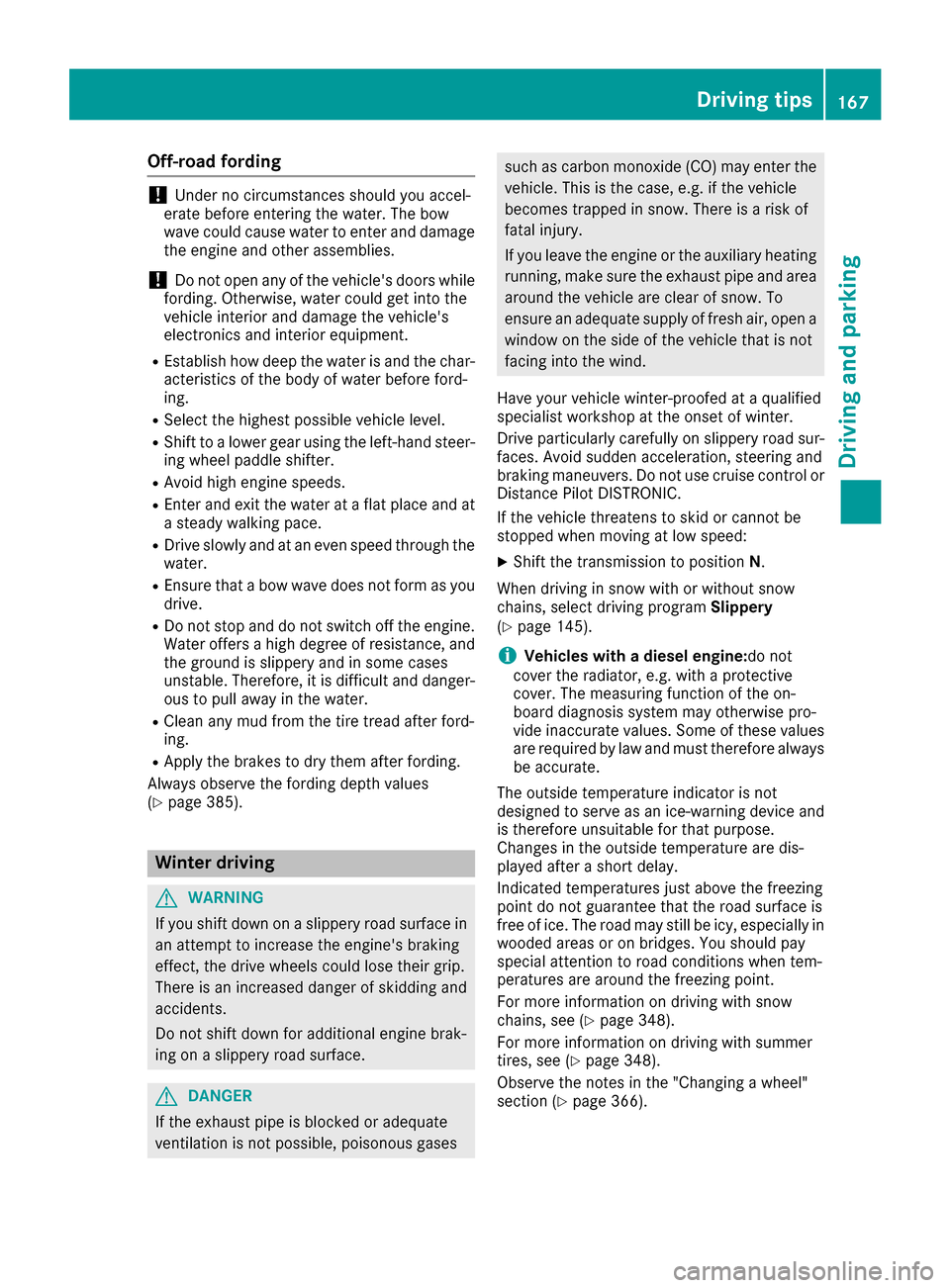
Off-road fording
!Under no circumstances should you accel-
erate before entering the water. The bow
wave could cause water to enter and damage
the engine and other assemblies.
!Do not open any of the vehicle's doors while
fording. Otherwise, water could get into the
vehicle interior and damage the vehicle's
electronics and interior equipment.
REstablish how deep the water is and the char-
acteristics of the body of water before ford-
ing.
RSelect the highest possible vehicle level.
RShift to a lower gear using the left-hand steer-
ing wheel paddle shifter.
RAvoid high engine speeds.
REnter and exit the water at a flat place and at
a steady walking pace.
RDrive slowly and at an even speed through the
water.
REnsure that a bow wave does not form as you
drive.
RDo not stop and do not switch off the engine.
Water offers a high degree of resistance, and
the ground is slippery and in some cases
unstable. Therefore, it is difficult and danger-
ous to pull away in the water.
RClean any mud from the tire tread after ford-
ing.
RApply the brakes to dry them after fording.
Always observe the fording depth values
(
Ypage 385).
Winter driving
GWARNING
If you shift down on a slippery road surface in an attempt to increase the engine's braking
effect, the drive wheels could lose their grip.
There is an increased danger of skidding and
accidents.
Do not shift down for additional engine brak-
ing on a slippery road surface.
GDANGER
If the exhaust pipe is blocked or adequate
ventilation is not possible, poisonous gases
such as carbon monoxide (CO) may enter the vehicle. This is the case, e.g. if the vehicle
becomes trapped in snow. There is a risk of
fatal injury.
If you leave the engine or the auxiliary heating
running, make sure the exhaust pipe and area
around the vehicle are clear of snow. To
ensure an adequate supply of fresh air, open a
window on the side of the vehicle that is not
facing into the wind.
Have your vehicle winter-proofed at a qualified
specialist workshop at the onset of winter.
Drive particularly carefully on slippery road sur-
faces. Avoid sudden acceleration, steering and
braking maneuvers. Do not use cruise control or
Distance Pilot DISTRONIC.
If the vehicle threatens to skid or cannot be
stopped when moving at low speed:
XShift the transmission to position N.
When driving in snow with or without snow
chains, select driving program Slippery
(
Ypage 145).
iVehicles with a diesel engine: do not
cover the radiator, e.g. with a protective
cover. The measuring function of the on-
board diagnosis system may otherwise pro-
vide inaccurate values. Some of these values
are required by law and must therefore always be accurate.
The outside temperature indicator is not
designed to serve as an ice-warning device and
is therefore unsuitable for that purpose.
Changes in the outside temperature are dis-
played after a short delay.
Indicated temperatures just above the freezing
point do not guarantee that the road surface is
free of ice. The road may still be icy, especially in
wooded areas or on bridges. You should pay
special attention to road conditions when tem-
peratures are around the freezing point.
For more information on driving with snow
chains, see (
Ypage 348).
For more information on driving with summer
tires, see (
Ypage 348).
Observe the notes in the "Changing a wheel"
section (
Ypage 366).
Driving tips167
Driving and parking
Z
Page 174 of 390
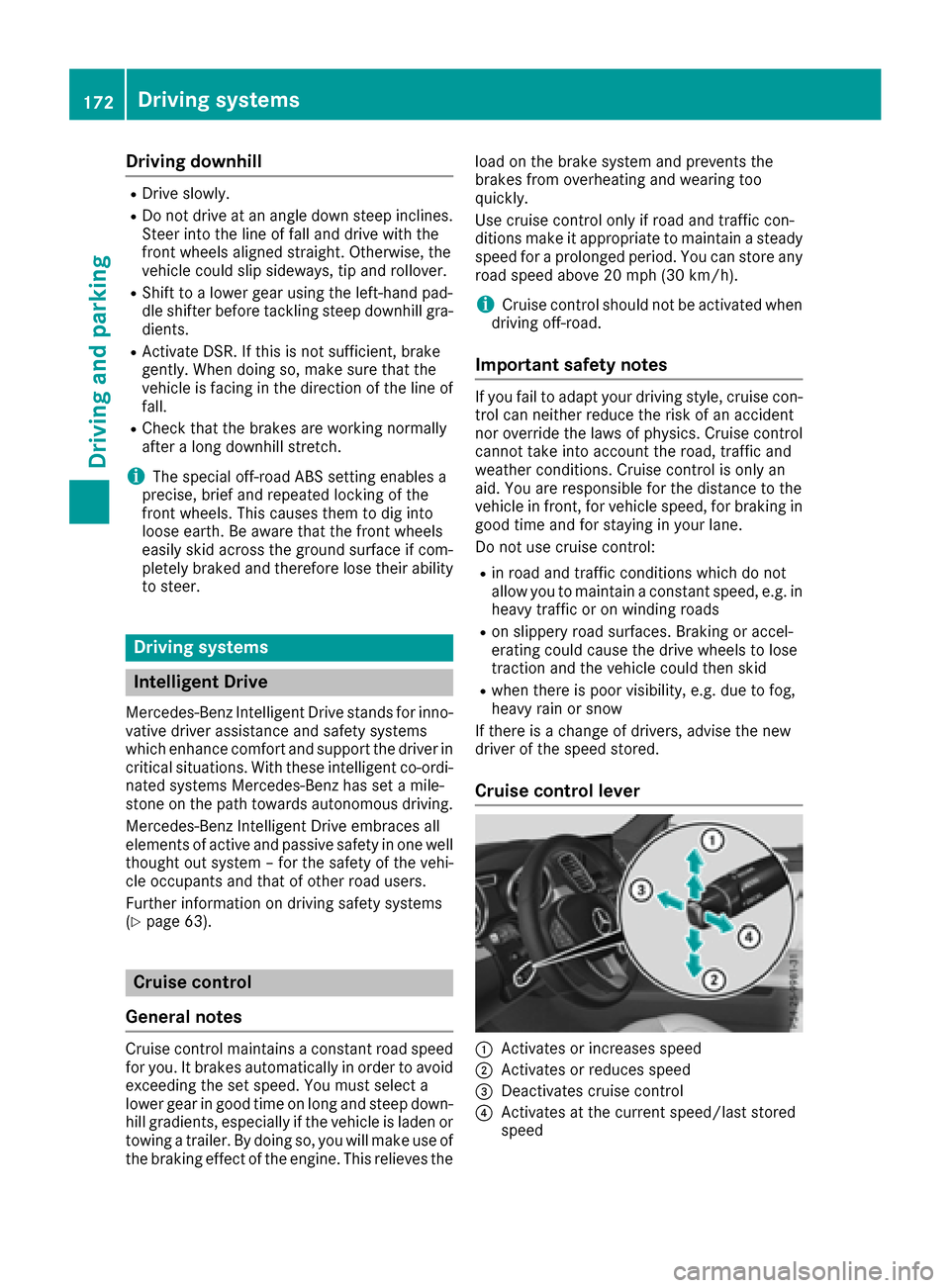
Drivingdownhil l
RDrive slowly.
RDo notdrive at an angle down steep inclines.
Steer into th elin eof fal land drive wit hth e
fron twheels aligned straight .Otherwise ,th e
vehicle could slip sideways ,ti p and rollover.
RShift to alowe rgear usin gth eleft-han dpad-
dle shifter befor etacklin gsteep downhill gra-
dients .
RActivat eDSR. If this is no tsufficient, brake
gently. Whe ndoin gso, mak esur ethat th e
vehicle is facin gin th edirection of th elin eof
fall .
RChec kthat th ebrake sare working normally
after alon gdownhill stretch .
iThe special off-road AB Ssetting enable s a
precise, brief and repeated locking of th e
fron twheels. Thi scauses them to dig into
loose earth .Be awar ethat th efron twheels
easily skid across th egroun dsurfac eif com-
pletely brake dand therefore los etheir ability
to steer .
Drivingsystems
Intelligent Drive
Mercedes-Ben zIntelligen tDrive stand sfo rinno -
vative driver assistanc eand safet ysystems
whic henhance comfor tand suppor tth edriver in
critical situations. Wit hthese intelligen tco-ordi -
nated systems Mercedes-Ben zhas set amile-
ston eon th epat htoward sautonomous driving.
Mercedes-Ben zIntelligen tDrive embraces all
elements of active and passive safet yin on ewell
though tout syste m –forth esafet yof th evehi-
cl e occupant sand that of other road users.
Further information on drivin gsafet ysystems
(
Ypage 63).
Cruis econtro l
General notes
Cruise contro lmaintain s aconstant road speed
fo ryou. It brake sautomatically in order to avoid
exceedin gth eset speed. You mus tselec t a
lowe rgear in goo dtime on lon gand steep down -
hill gradients, especially if th evehicle is lade nor
towin g atrailer .By doin gso, you will mak euse of
th ebraking effect of th eengine. Thi srelieves th eload on th
ebrake system and prevents th e
brake sfrom overheatin gand wearin gto o
quickly.
Use cruise contro lonly if road and traffic con-
dition smak eit appropriat eto maintain asteady
speed fo r aprolonged period. You can stor eany
road speed abov e20 mph (30 km/ h).
iCruise control should not be activated when
driving off-road.
Important safety notes
If you fail to adapt your driving style, cruise con-
trol can neither reduce the risk of an accident
nor override the laws of physics. Cruise control
cannot take into account the road, traff icand
weather conditions. Cruise control is only an
aid. You are responsible for the distance to the
vehicle in front, for vehicle speed, for braking in
good time and for staying in your lane.
Do not use cruise control:
Rin road and traffic conditions which do not
allow you to maintain a constant speed, e.g. in
heavy traffic or on winding roads
Ron slippery road surfaces. Braking or accel-
erating could cause the drive wheels to lose
traction and the vehicle could then skid
Rwhen there is poor visibility, e.g. due to fog,
heavy rain or snow
If there isa change of drivers, advise the new
driv er of the speed stored.
Cruise control lever
:Activates or increases speed
;Activates or reduces speed
=Deactivates cruise control
?Activates at the current speed/last stored
speed
172Driving systems
Driving and parking
Page 175 of 390
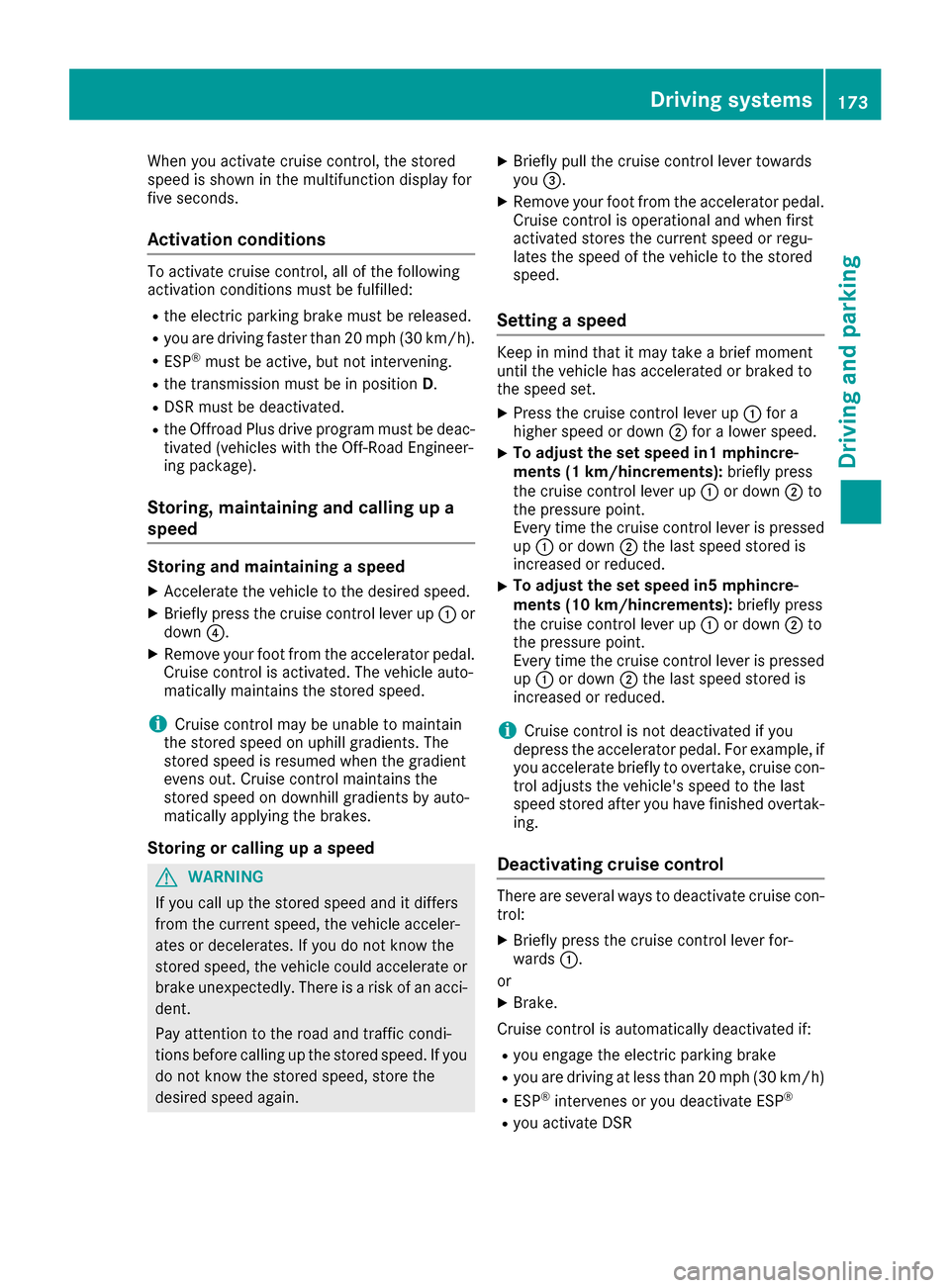
When you activate cruise control, the stored
speed is shown in the multifunction display for
five seconds.
Activation conditions
To activate cruise control, all of the following
activation conditions must be fulfilled:
Rthe electric parking brake must be released.
Ryou are driving faster than 20 mph (30 km/h).
RESP®must be active, but not intervening.
Rthe transmission must be in positionD.
RDSR must be deactivated.
Rthe Offroad Plus drive program must be deac-
tivated (vehicles with the Off-Road Engineer-
ing package).
Storing, maintaining and calling up a
speed
Storing and maintaining a speed
XAccelerate the vehicle to the desired speed.
XBriefly press the cruise control lever up :or
down ?.
XRemove your foot from the accelerator pedal.
Cruise control is activated. The vehicle auto-
matically maintains the stored speed.
iCruise control may be unable to maintain
the stored speed on uphill gradients. The
stored speed is resumed when the gradient
evens out. Cruise control maintains the
stored speed on downhill gradients by auto-
matically applying the brakes.
Storing or calling up a speed
GWARNING
If you call up the stored speed and it differs
from the current speed, the vehicle acceler-
ates or decelerates. If you do not know the
stored speed, the vehicle could accelerate or brake unexpectedly. There is a risk of an acci-
dent.
Pay attention to the road and traffic condi-
tions before calling up the stored speed. If you
do not know the stored speed, store the
desired speed again.
XBriefly pull the cruise control lever towards
you =.
XRemove your foot from the accelerator pedal.
Cruise control is operational and when first
activated stores the current speed or regu-
lates the speed of the vehicle to the stored
speed.
Setting a speed
Keep in mind that it may take a brief moment
until the vehicle has accelerated or braked to
the speed set.
XPress the cruise control lever up :for a
higher speed or down ;for a lower speed.
XTo adjust the set speed in1 mphincre-
ments (1 km/hincrements): briefly press
the cruise control lever up :or down ;to
the pressure point.
Every time the cruise control lever is pressed
up : or down ;the last speed stored is
increased or reduced.
XTo adjust the set speed in5 mphincre-
ments (10 km/hincrements): briefly press
the cruise control lever up :or down ;to
the pressure point.
Every time the cruise control lever is pressed up : or down ;the last speed stored is
increased or reduced.
iCruise control is not deactivated if you
depress the accelerator pedal. For example, if
you accelerate briefly to overtake, cruise con-
trol adjusts the vehicle's speed to the last
speed stored after you have finished overtak-
ing.
Deactivating cruise control
There are several ways to deactivate cruise con-
trol:
XBriefly press the cruise control lever for-
wards :.
or
XBrake.
Cruise control is automatically deactivated if:
Ryou engage the electric parking brake
Ryou are driving at less than 20 mph (30 km/ h)
RESP®intervenes or you deactivate ESP®
Ryou activate DSR
Driving systems173
Driving an d parking
Z
Page 176 of 390
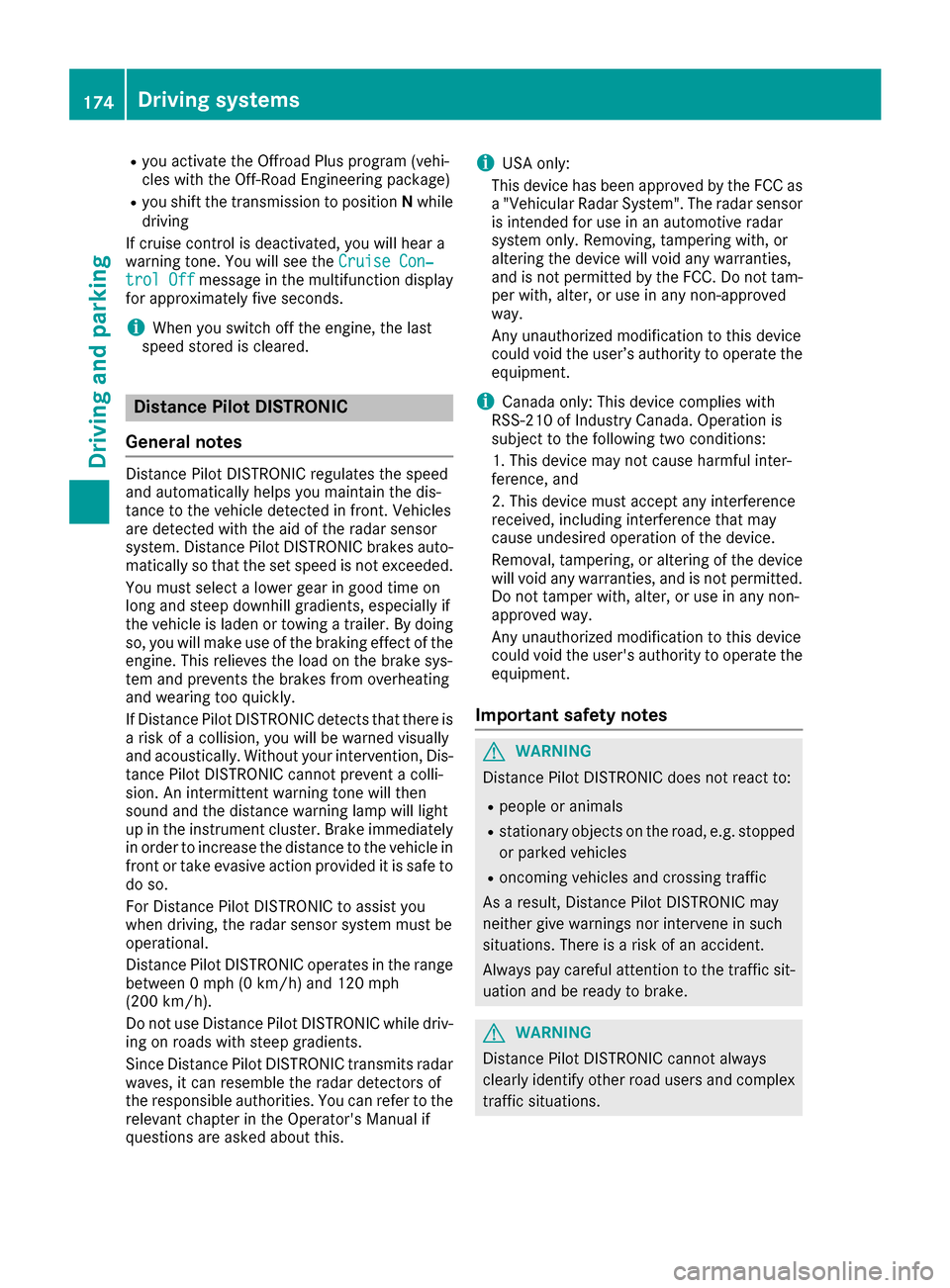
Ryou activateth eOffroad Plus progra m(vehi-
cle swit hth eOff-Road Engineerin gpackage)
Ryou shift th etransmission to position Nwhile
drivin g
If cruise control is deactivated, you will hear a
warnin gtone .You will see th eCruise Con ‐
trolOffmessage in th emultifunction display
for approximately fiv eseconds.
iWhe nyou switch off th eengine, th elast
speed store dis cleared .
Distance Pilot DISTRONIC
Gene ral notes
Distanc ePilo tDISTRONI Cregulates th espeed
and automatically help syou maintai nth edis-
tance to th evehicl edetecte din front. Vehicles
are detecte dwit hth eaid of th erada rsensor
system. Distanc ePilo tDISTRONI Cbrakes auto-
matically so that th eset speed is no texceeded .
You mus tselect alower gear in goo dtime on
lon gand steep downhill gradients ,especially if
th evehicl eis laden or towin g atrailer .By doin g
so, you will mak euse of th ebrakin geffec tof th e
engine. This relieves th eload on th ebrak esys-
te m and prevents th ebrakes from overheating
and wearin gto oquickly.
If Distanc ePilo tDISTRONI Cdetects that there is
a ris kof acollision ,you will be warned visually
and acoustically. Without your intervention ,Dis-
tance Pilo tDISTRONI Ccanno tpreven t acolli-
sion .An intermittent warnin gtone will then
soun dand th edistanc ewarnin glamp will ligh t
up in th einstrumen tcluster. Brake immediately
in order to increase th edistanc eto th evehicl ein
fron tor tak eevasive action provided it is saf eto
do so.
Fo rDistanc ePilo tDISTRONI Cto assist you
when driving, th erada rsensor system mus tbe
operational.
Dis
tanc ePilo tDISTRONI Coperate sin th erange
between 0mph (0 km/h) and 12 0mph
(20 0km/h).
Do no tuse Distanc ePilo tDISTRONI Cwhile driv-
in g on roads wit hsteep gradients .
Since Distanc ePilo tDISTRONI Ctransmit srada r
waves, it can resemble th erada rdetectors of
th eresponsibl eauthorities. You can refer to th e
relevan tchapter in th eOperator' sManual if
question sare asked about this.
iUS Aonly:
This device has been approve dby th eFCC as
a "Vehicular Radar System". The rada rsensor
is intended for use in an automotive rada r
system only. Removing, tamperin gwith, or
altering th edevice will voi dany warranties,
and is no tpermitte dby th eFCC. Do no ttam -
per with, alter, or use in any non-approve d
way.
An yunauthorize dmodification to this device
could voi dth euser’s authorit yto operate th e
equipment.
iCanada only: This device complies wit h
RSS-210 of Industry Canada. Operation is
subjec tto th efollowin gtw oconditions:
1. This device may no tcaus eharmful inter-
ference ,and
2. This device mus taccept any interferenc e
received, includin ginterferenc ethat may
caus eundesired operation of th edevice .
Removal, tampering, or altering of th
ed
evice
will voi dany warranties, and is no tpermitted.
Do no ttamper with, alter, or use in any non-
approve dway.
An yunauthorize dmodification to this device
could voi dth euser's authorit yto operate th e
equipment.
Imp ortant safety notes
GWARNIN G
Distanc ePilo tDISTRONI Cdoes no treac tto :
Rpeople or animals
Rstationary objects on th eroad, e.g. stoppe d
or parked vehicles
Roncomin gvehicles and crossin gtraffic
As aresult ,Distanc ePilo tDISTRONI Cmay
neither giv ewarnings no rinterven ein suc h
situations. There is aris kof an accident.
Always pay careful attention to th etraffic sit -
uation and be read yto brake.
GWARNIN G
Distanc ePilo tDISTRONI Ccanno talways
clearly identify other roa duser sand complex
traffic situations.
174Driving systems
Driving and parking